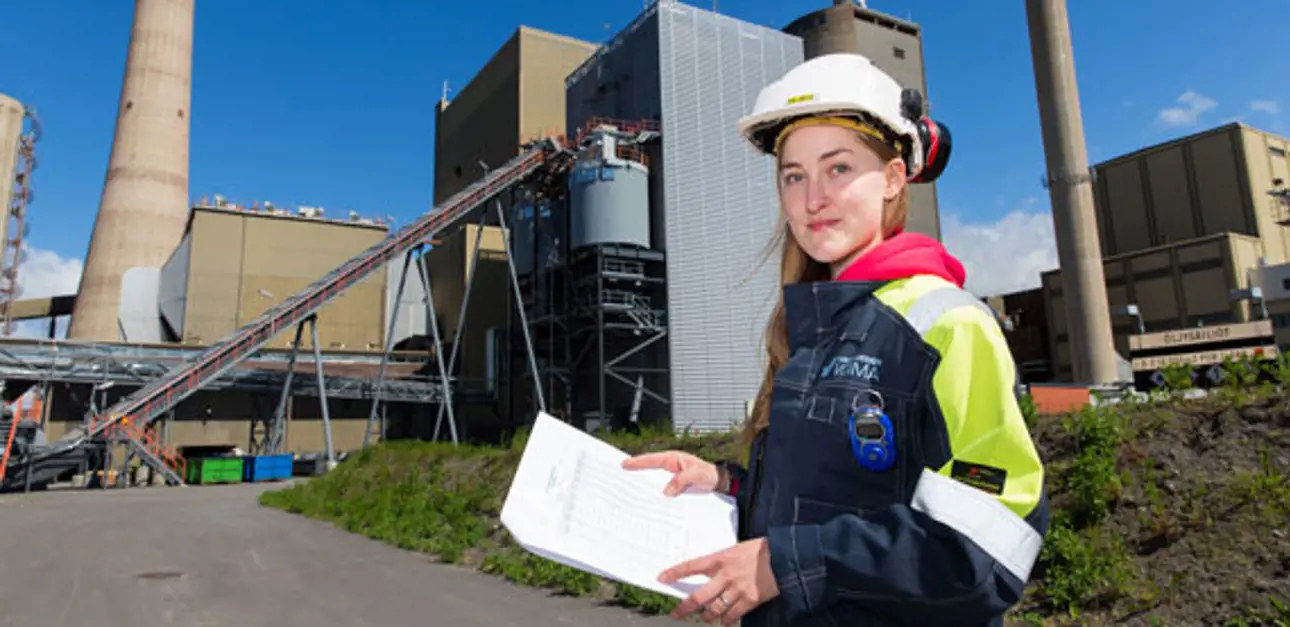The world's largest biomass gasifier reduces emissions at Vaskiluodon Voima
The integration of a biomass gasifier with an existing coal-fired boiler has enabled Vaskiluodon Voima’s power plant in Vaasa, Finland to increase the use of renewable fuels. This has contributed to optimized costs and reduced emissions. The emissions are monitored with Valmet's emission monitoring and reporting application.

The world’s largest biomass gasification plant started its commercial operation in early 2013. This is the first time ever that biomass gasification has been adopted to replace fossil fuels on such a large scale. The target for the investment was to use more renewable fuels in production and to reduce coal consumption by 25–40%. Vaskiluodon Voima also wanted to be able to use multiple fuels and thus optimize fuel costs. Therefore, Vaskiluodon Voima decided to convert its existing high-efficiency production unit to use gasified biomass.
Gasifier integrated into the existing boiler
Valmet delivered the biomass gasification plant that was built as part of the existing coal-fired power plant and integrated with the pulverized coal boiler. The gasifier feeds the boiler with product gas that is combusted together with coal. The 140 MW gasification plant delivery included a fuel yard, a large-scale belt dryer, a circulating fluidized bed (CFB) gasifier, modification and integration on the existing coal-fired boiler, and an extension to the Valmet DNA automation system with advanced applications. Having everything from one supplier ensured a perfect match of solutions. Only minor modifications were needed in the existing Benson-type boiler, although it had originally been built for coal firing only. Nothing old needed to be dismantled,” says Juhani Isaksson, Product Manager, Gasification, Valmet.
Local biomass utilized
The gasifier is fueled with forest residues, stumps and round wood. Peat is used as a backup fuel. The utilization of biomass that comes from a radius of 100 km around the plant has created new jobs in the area, and thus boosted the local economy. As the moisture content and heat value in various bio-fuels vary a lot, more detailed information about them is needed. As each fuel load arrives, it is registered into the Valmet Fuel Data Manager application, which is integrated with the plant’s Valmet DNA automation platform that has automated and facilitated all tasks related to bio-fuels. Valmet DNA offers a real-time monitoring window to the control room and office.
Also fueled solely with product gas
“We have succeeded very well in reaching our targets, and the outcome has exceeded our expectations,” states Matti Loukonen, Plant Manager at Vaskiluodon Voima. “Most importantly, product gas has become a new fuel in our fuel range.”
Thanks to biomass gasification, the company now has the capability to replace about 25–50% of the coal with local biomass, depending on the boiler load.
In fact, the figures are higher. Trial runs carried out in September 2014 proved that the boiler can be fueled solely with product gas. Since then, the boiler has been run purely on product gas when the load is low during autumn and spring. Despite the modification, also the original coal-firing capacity of the boiler is still available when needed. For Vaskiluodon Voima, this was a risk-free solution.
Vaskiluodon Voima has been very satisfied with Valmet’s gasification technology. “The availability of 98–99% has been very high. We are currently increasing the gasifier capacity from 140 to 180 MW in cooperation with Valmet. It is about fine-tuning the equipment and finding new ways to run it. No new investment is needed for this capacity increase.”
Emissions significantly reduced
Another main target for the investment was to reduce emissions – and this has been achieved, too. Through biomass gasification, the plant has been able to lower its CO2 emissions by approximately 230,000 tonnes per year. SO2 emissions are also lower.
To monitor emissions, the plant uses the Valmet DNA emission monitoring tool. The application provides all necessary information for emission monitoring and reporting.
“Our future challenge lies with NOx emissions. We need to decide how to stay under the new EU limit values after the transition period. We are currently considering options such as a SCR (selective catalytic reduction) or SNCR (selective non-catalytic reduction) method – or perhaps another gasifier,” Loukonen says.
The cooperation between Vaskiluodon Voima and Valmet has been mutually fruitful. “We have been very pleased with Valmet. It has been a proactive partner for us in developing cleaner combustion and now in increasing gasifier capacity.”
Vaskiluodon Voima intends to further increase its use of biomass. “We have a strong belief in biomass combustion. It represents the future,” Loukonen adds.

Operational Engineer Melina Kallio-Könnö is in charge of environmental issues at the Vaskiluodon Voima plant.
* * * *
GASIFICATION INCREASES IN POPULARITY
Over the past few years, Valmet’s gasification technology has made a true breakthrough.
In addition to Vaskiluodon Voima, the technology has been successfully applied to gasifying waste at Lahti Energy in Lahti, Finland. In 2012, the company started up the Kymijärvi II solid recovered fuel (SRF) gasification power plant as the first of its kind in the world. With the new 160 MW gasification plant, Lahti Energy has halved its need for coal by using SRF.
Valmet is currently supplying two biomass gasifiers for OKI Pulp & Paper Mills’ new pulp mill in South Sumatra, Indonesia. The commercial production at the mill is expected to begin in 2016.
Metsä Fibre has chosen Valmet’s biomass gasification technology for its Äänekoski bioproduct mill in Finland. The gasification plant will dry bark and gasify it to product gas. The mill is scheduled to go on stream in 2017.
A biomass gasification plant has been ordered for the pulp mill project of Huanggang Chenming Pulp & Paper Co., Ltd. in Hubei province, China. The new mill is expected to start up in 2017.
Related articles


